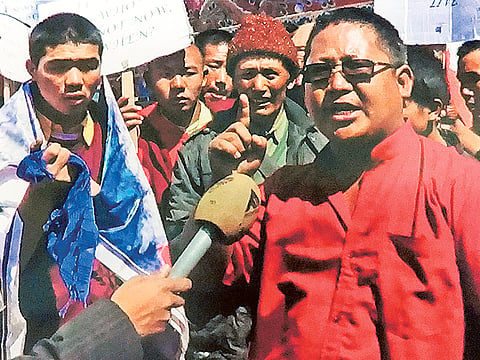Buddhist monk fights for protection of Black-necked crane
Buddhist monk is among several unsung heroes quietly working to protect country’s wildlife

Mumbai: For the Buddhist monks of Arunachal Pradesh in north-east India, a life of spirituality also involves fighting for the protection of the magnificent and rare Black-necked crane found exclusively in the Tawang region.
One lama in particular has fearlessly fought against the 780MW Nyamjang Chhu hydroelectric project which directly impacted a 3km stretch of the Nyamjang Chhu river that was a critical wintering site of this vulnerable, as well as an auspicious, bird for the people living here. In this battle,
“I have been threatened, arrested, put in jail and when the people were upset and tried to rescue me, there was police firing in which two of my friends were killed on May 2, 2016,” Lobsang Gyatso, 36, told Gulf News. He says he was arrested on the false charge “of creating communal tension,” when opposing the project.
He is among several brave but unsung heroes who have been quietly working hard to protect the country’s wildlife. All of them are being felicitated in Mumbai with Sanctuary Wildlife Awards 2016 on December 2, now in its 17th year.
Bittu Sahgal, founder and editor of Sanctuary Asia, describes them as Earth Heroes who “do what they do from inner conviction, undeterred by threats and obstacles.”
Spearheading a movement, the Save Mon Region Federation, to safeguard the ecological security of the Mon-Tawang region, home to the Buddhist Monpa community, Gyatso says their appeal to the National Green Tribunal resulted in suspension of environmental clearance in April 2016. A public hearing and a resurvey of the project will be held now. He adds there are 12 other projects in a similar status and what is disturbing is that even though there are other completed projects, “we do not get electricity, especially during winter. There is a lot of corruption here.”
Through rallies, campaigns, meeting parliamentarians in Delhi, reporting environment and forest violations to the Forest and Environment ministry, legal action, documentation of culturally and ecologically-sensitive sites affected by these projects have been the norm for this activist, who worries that the BJP government at the centre “uses force”, unlike the previous UPA government.
The battle, however, paid off when this winter the black-necked cranes, which breed on the Tibetan plateau, returned to Arunachal Pradesh.
Another lifetime service award went to S.E.H Kazmi of the Palamau Tiger Reserve whose entire career has been a courageous one in standing against forces destroying nature in conflict-ridden landscape. His reports against the Kutku dam project in Bihar-Jharkhand and unflinching support to the affected villagers played a key role in stalling the ill-conceived project. Crackdowns on poaching gangs and illegal ‘katha’ (catechu used in beetle leaves) smugglers in Palamau even led to a bid on his life in 1998. He even convinced the Army to give up plans to create a firing range at the southern end of Palamau and ensured that the Holilong UG mining project did not see the light of day.
The Sancturay awards, supported by DSP Blackrock and Deutsche Bank, India, has recognised several others, including youth who represent the best of conservation and earth-patriotism.
Sign up for the Daily Briefing
Get the latest news and updates straight to your inbox


